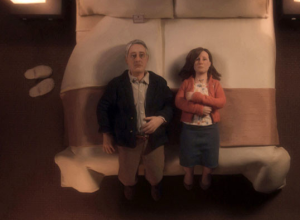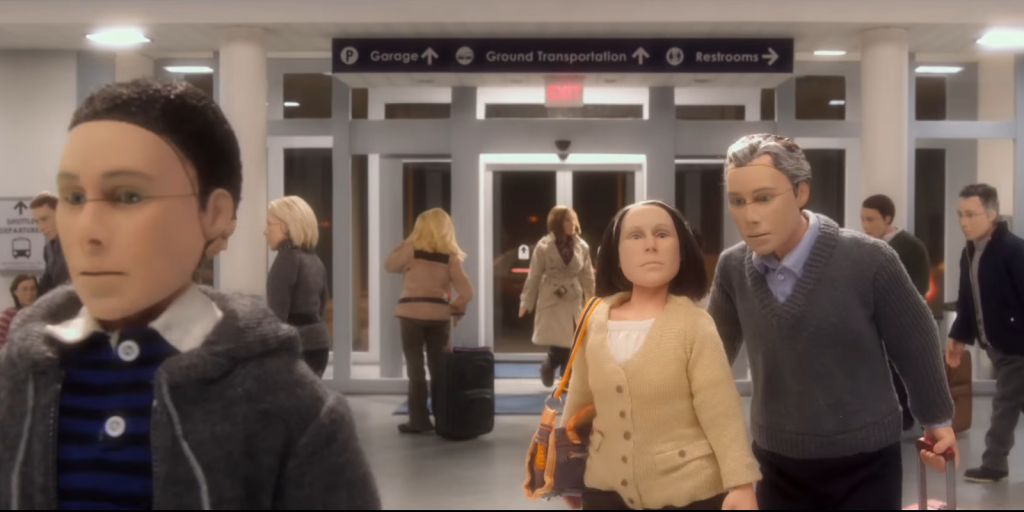Animation for adults. When did that begin? And what ever relegated cartoons to the realm of children? Aren’t we all children inside after all? Aren’t adults just children in grown people’s clothing, waiting to burst out from their fake confining roles and really live again? What’s real and what’s fake anyway? How does 3D printing play into these questions, when used in animated film?
Director Charlie Kaufman is no stranger to these themes. After all, he directed the cult classic film Eternal Sunshine of the Spotless Mind, starring Kate Winslet and Jim Carrey. When his producer/friend Dino Stamatopolous approached him about directing a film for his new stop-motion studio, Starburns Industries, Kaufman was wary about the financing. But after a successful Kickstarter campaign, Kaufman and his co-director, Duke Johnson, were able to secure the entire $8 million needed to go forward. And forward they went, completing the animated film Anomalisa using 3D printed faces for their puppet-characters. The effect is quite dramatic, indeed. Almost surreal.
The film, scheduled for a limited release on December 30th and full release in January, is about the modern difficulties establishing human connection, and it embraces both artifice and real effects. 3D printing, which I argue is a little bit of both, fits in perfectly here. The set used a dozen puppets of the main characters, Michael and Lisa. Michael (voice of David Thewlis) is an inspirational speaker who is on his way to a nervous breakdown at a Cincinnati hotel when he meets Lisa (voice of Jennifer Jason Leigh). In its-two year production time, the set used 30 animators, about 100 feet of hallway, 18 stages, and 10 motion control rigs–and 1,261 faces.
But a grand production budget isn’t the point of this film, it seems. Anomalisa is an adult-themed stop-motion reflection on the vulnerability and frailty exhibited in human relationships. (I wonder if the title borrows from French sociologist Emile Durkheim concept of “anomie,” which describes social alienation and disconnection?) The film, shot frame by frame using puppets, does a good job communicating this vulnerability. The puppets have visible seams on them, and they were shot with the understanding that the audience would be more aware of a puppet performing certain mundane tasks, like shaving, than a real human.
But what appears to establish the puppets’ humanity are their faces. The faces, 3D printed with all of the real-life details you would imagine, like wrinkles and bags under the eyes, seem to serve as a bridge between the artificial and real world struggle that is the film’s overall theme. According to one review, “…the eyes, expressions and movements are believable. The awkwardness and desperation are very tangible and empathetic.”
In an interview , co-director Johnson explains that 3D printing established the inner feelings of the characters and was also essential because “you get a higher level of detail in the animation using 3D printing,” making it more cost-effective overall.
, co-director Johnson explains that 3D printing established the inner feelings of the characters and was also essential because “you get a higher level of detail in the animation using 3D printing,” making it more cost-effective overall.
We have seen Hollywood turn more and more to 3D printing for special effects for horror and science fiction, like Alchemy Studios, for example. Anomalisa is yet another example of a very original use of the technology. In fact, it is difficult to image these puppet-characters with any other kind of face except the 3D printed kind. The technology plays a very big role in this film’s ability to tackle the big questions posed in the very beginning of the film’s trailer, which you can watch below: “What is it to be human? What is it to ache? What is it to be alive?”
Discuss this use of 3D Printing in the Anomolisa Forum thread on 3DPB.com
Subscribe to Our Email Newsletter
Stay up-to-date on all the latest news from the 3D printing industry and receive information and offers from third party vendors.
You May Also Like
Gorilla Sports GE’s First 3D Printed Titanium Cast
How do you help a gorilla with a broken arm? Sounds like the start of a bad joke a zookeeper might tell, but it’s an actual dilemma recently faced by...
Nylon 3D Printed Parts Made More Functional with Coatings & Colors
Parts 3D printed from polyamide (PA, Nylon) 12 using powder bed fusion (PBF) are a mainstay in the additive manufacturing (AM) industry. While post-finishing processes have improved the porosity of...
$25M to Back Sintavia’s Largest Expansion of Metal 3D Printing Capacity Since 2019
Sintavia, the digital manufacturing company specializing in mission-critical parts for strategic sectors, announced a $25 million investment to increase its production capacity, the largest expansion to its operations since 2019....
Velo3D Initiates Public Offering in a Bid to Strengthen Financial Foundations and Drive Future Growth
Velo3D (NYSE: VLD) has been among a number of publicly traded 3D printing firms that have attempted to weather the current macroeconomic climate. After posting a challenging financial report for 2023,...

































